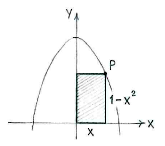Lösung 1.3:4
Aus Online Mathematik Brückenkurs 2
K (Solution 1.3:4 moved to Lösung 1.3:4: Robot: moved page) |
|||
| Zeile 1: | Zeile 1: | ||
| - | + | Wir benennen die ''x''-Koordinate des Punktes <math>P</math> <math>x</math>. Die ''y''Koordinate ist dann <math>1-x^{2}</math>, nachdem <math>P</math> auf der Kurve <math>y=1-x^{2}</math> liegt. | |
[[Image:1_3_4-1-1.gif|center]] | [[Image:1_3_4-1-1.gif|center]] | ||
| - | + | Die Fläche des Rechteckes ist | |
| - | {{Abgesetzte Formel||<math>A(x) = \text{( | + | {{Abgesetzte Formel||<math>A(x) = \text{(Basis)}\cdot\text{(Höhe)} = x\cdot (1-x^2)</math>}} |
| - | + | Wir wollen diese Fläche in Bezug auf ''x'' maximieren. | |
| - | + | Wir sehen von der Figur her dass <math>P</math> in der ersten Quadrante liegen muss, <math>x\ge 0</math>, und also <math>y=1-x^2\ge 0</math>, und wir erhalten dass <math>x\le 1</math>. Also suchen wir das Maxima von<math>A(x)</math> im Bereich <math>0\le x\le 1\,</math>. | |
| - | There are three types of points which can maximise the area function: | ||
| - | + | Lokale Extrempunkte der Fläche sind entweder: | |
| - | + | ||
| - | + | ||
| - | + | # stationäre Punkte, wo <math>f^{\,\prime}(x)=0</math>, | |
| + | # Singuläre Punkte, wo die Funktion nicht ableitbar ist, oder | ||
| + | # Endpunkte. | ||
| + | Die Funktion <math>A(x) = x(1-x^2)</math> ist überall differenzierbar, so der wir müssen den 2:en Fall nicht beachten. Die Endpunkte <math>A(0) = A(1) = 0\,</math> können aber lokale Extrempunkte sein (offenbar lokale Minima, siehe Figur). | ||
| - | + | Die Ableitung der Funktion ist | |
{{Abgesetzte Formel||<math>A'(x) = 1\cdot (1-x^2) + x\cdot (-2x) = 1-3x^2\,,</math>}} | {{Abgesetzte Formel||<math>A'(x) = 1\cdot (1-x^2) + x\cdot (-2x) = 1-3x^2\,,</math>}} | ||
| - | + | und wir erhalten die Gleichung <math>x=\pm 1/\!\sqrt{3}</math> für die stationären Punkte. Nur die Lösung <math>x=1/\!\sqrt{3}</math> erfüllt aber <math>0\le x\le 1</math>. | |
| - | + | Die zweite Ableitung <math>A''(x)=-6x</math> hat im stationären Punkt den Wert | |
{{Abgesetzte Formel||<math>A''\bigl( 1/\!\sqrt{3}\bigr) = -6\cdot\frac{1}{\sqrt{3}} < 0\,,</math>}} | {{Abgesetzte Formel||<math>A''\bigl( 1/\!\sqrt{3}\bigr) = -6\cdot\frac{1}{\sqrt{3}} < 0\,,</math>}} | ||
| - | + | und also ist <math>x=1/\!\sqrt{3}</math> ein lokales Maxima. | |
| - | + | Also ist der optimale Punkt <math>P</math>: | |
{{Abgesetzte Formel||<math>P = \Bigl(\frac{1}{\sqrt{3}}, 1-\Bigl(\frac{1}{\sqrt{3}} \Bigr)^2\, \Bigr) = \Bigl(\frac{1}{\sqrt{3}}, \frac{2}{3} \Bigr)\,\textrm{.}</math>}} | {{Abgesetzte Formel||<math>P = \Bigl(\frac{1}{\sqrt{3}}, 1-\Bigl(\frac{1}{\sqrt{3}} \Bigr)^2\, \Bigr) = \Bigl(\frac{1}{\sqrt{3}}, \frac{2}{3} \Bigr)\,\textrm{.}</math>}} | ||
Version vom 11:39, 27. Apr. 2009
Wir benennen die x-Koordinate des Punktes \displaystyle P \displaystyle x. Die yKoordinate ist dann \displaystyle 1-x^{2}, nachdem \displaystyle P auf der Kurve \displaystyle y=1-x^{2} liegt.
Die Fläche des Rechteckes ist
| \displaystyle A(x) = \text{(Basis)}\cdot\text{(Höhe)} = x\cdot (1-x^2) |
Wir wollen diese Fläche in Bezug auf x maximieren.
Wir sehen von der Figur her dass \displaystyle P in der ersten Quadrante liegen muss, \displaystyle x\ge 0, und also \displaystyle y=1-x^2\ge 0, und wir erhalten dass \displaystyle x\le 1. Also suchen wir das Maxima von\displaystyle A(x) im Bereich \displaystyle 0\le x\le 1\,.
Lokale Extrempunkte der Fläche sind entweder:
- stationäre Punkte, wo \displaystyle f^{\,\prime}(x)=0,
- Singuläre Punkte, wo die Funktion nicht ableitbar ist, oder
- Endpunkte.
Die Funktion \displaystyle A(x) = x(1-x^2) ist überall differenzierbar, so der wir müssen den 2:en Fall nicht beachten. Die Endpunkte \displaystyle A(0) = A(1) = 0\, können aber lokale Extrempunkte sein (offenbar lokale Minima, siehe Figur).
Die Ableitung der Funktion ist
| \displaystyle A'(x) = 1\cdot (1-x^2) + x\cdot (-2x) = 1-3x^2\,, |
und wir erhalten die Gleichung \displaystyle x=\pm 1/\!\sqrt{3} für die stationären Punkte. Nur die Lösung \displaystyle x=1/\!\sqrt{3} erfüllt aber \displaystyle 0\le x\le 1.
Die zweite Ableitung \displaystyle A''(x)=-6x hat im stationären Punkt den Wert
| \displaystyle A''\bigl( 1/\!\sqrt{3}\bigr) = -6\cdot\frac{1}{\sqrt{3}} < 0\,, |
und also ist \displaystyle x=1/\!\sqrt{3} ein lokales Maxima.
Also ist der optimale Punkt \displaystyle P:
| \displaystyle P = \Bigl(\frac{1}{\sqrt{3}}, 1-\Bigl(\frac{1}{\sqrt{3}} \Bigr)^2\, \Bigr) = \Bigl(\frac{1}{\sqrt{3}}, \frac{2}{3} \Bigr)\,\textrm{.} |

